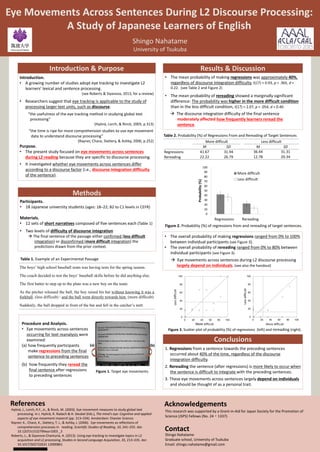Eye movements across sentences during L2 discourse processing: A study of Japanese learners of English.
- 1. Eye Movements Across Sentences During L2 Discourse Processing: A Study of Japanese Learners of English Shingo Nahatame University of Tsukuba Shingo Nahatame Graduate school, University of Tsukuba Email: shingo.nahatame@gmail.com Contact Hy├Čn├ż, J., Lorch, R.F., Jr., & Rinck, M. (2003). Eye movement measures to study global text processing. In J. Hy├Čn├ż, R. Radach & H. Deubel (Eds.), The mind's eye: Cognitive and applied aspects of eye movement research (pp. 313ŌĆō334). Amsterdam: Elsevier Science. Rayner, K., Chace, K., Slattery, T. J., & Ashby, J. (2006). Eye movements as reflections of comprehension processes in reading. Scientific Studies of Reading, 10, 241ŌĆō255. doi: 10.1207/s1532799xssr1003 _3 Roberts, L., & Siyanova-Chanturia, A. (2013). Using eye-tracking to investigate topics in L2 acquisition and L2 processing. Studies in Second Language Acquisition, 35, 213ŌĆō235. doi: 10.1017/S02722631 12000861 References Introduction. ŌĆó A growing number of studies adopt eye tracking to investigate L2 learnersŌĆÖ lexical and sentence processing. (see Roberts & Siyanova, 2013, for a review) ŌĆó Researchers suggest that eye tracking is applicable to the study of processing larger text units, such as discourse. ŌĆ£the usefulness of the eye tracking method in studying global text processingŌĆØ (Hy├Čn├ż, Lorch, & Rinck, 2003, p.313) ŌĆ£the time is ripe for more comprehension studies to use eye movement data to understand discourse processingŌĆØ (Rayner, Chace, Slattery, & Ashby, 2006, p.252) Purpose. ŌĆó The present study focused on eye movements across sentences during L2 reading because they are specific to discourse processing. ŌĆó It investigated whether eye movements across sentences differ according to a discourse factor (i.e., discourse integration difficulty of the sentence). Introduction & Purpose ŌĆó The mean probability of making regressions was approximately 40%, regardless of discourse integration difficulty, t(17) = 0.93, p = .365, d = 0.22. (see Table 2 and Figure 2) ŌĆó The mean probability of rereading showed a marginally significant difference: The probability was higher in the more difficult condition than in the less difficult condition, t(17) = 2.07, p = .054, d = 0.40. ’āĀ The discourse integration difficulty of the final sentence moderately affected how frequently learners reread the sentence. Methods 1. Regressions from a sentence towards the preceding sentences occurred about 40% of the time, regardless of the discourse integration difficulty. 2. Rereading the sentence (after regressions) is more likely to occur when the sentence is difficult to integrate with the preceding sentences. 3. These eye movements across sentences largely depend on individuals and should be thought of as a personal trait. Conclusions Participants. ŌĆó 18 Japanese university students (ages: 18ŌĆō22; B2 to C1 levels in CEFR) Materials. ŌĆó 12 sets of short narratives composed of five sentences each (Table 1) ŌĆó Two levels of difficulty of discourse integration ’āĀ The final sentence of the passage either confirmed (less difficult integration) or disconfirmed (more difficult integration) the predictions drawn from the prior context. Results & Discussion 0 20 40 60 80 100 0 20 40 60 80 100 Lessdifficult More difficult Figure 3. Scatter plot of probability (%) of regressions (left) and rereading (right). Figure 1. Target eye movements. (b) Table 1. Example of an Experimental Passage The boysŌĆÖ high school baseball team was having tests for the spring season. The coach decided to test the boysŌĆÖ baseball skills before he did anything else. The first batter to step up to the plate was a new boy on the team. As the pitcher released the ball, the boy raised his bat without knowing it was a forkball. (less difficult) / and the ball went directly towards him. (more difficult) Suddenly, the ball dropped in front of the bat and fell in the catcherŌĆÖs mitt. Procedure and Analysis. ŌĆó Eye movements across sentences occurring for text reanalysis were examined: (a) how frequently participants make regressions from the final sentence to preceding sentences (b) how frequently they reread the final sentence after regressions to preceding sentences (a) 0 20 40 60 80 100 0 20 40 60 80 100 Lessdifficult More difficult Figure 2. Probability (%) of regressions from and rereading of target sentences. More difficult Less difficult M SD M SD Regressions 41.67 31.94 36.44 31.31 Rereading 22.22 26.79 12.78 20.34 0 10 20 30 40 50 60 70 80 90 100 Regressions Rereading Probability(%) More difficult Less difficult Table 2. Probability (%) of Regressions From and Rereading of Target Sentences ŌĆó The overall probability of making regressions ranged from 0% to 100% between individual participants (see Figure 3). ŌĆó The overall probability of rereading ranged from 0% to 80% between individual participants (see Figure 3). ’āĀ Eye movements across sentences during L2 discourse processing largely depend on individuals. (see also the handout) Acknowledgements This research was supported by a Grant-in-Aid for Japan Society for the Promotion of Science (JSPS) Fellows (No. 24Ńā╗1337).

